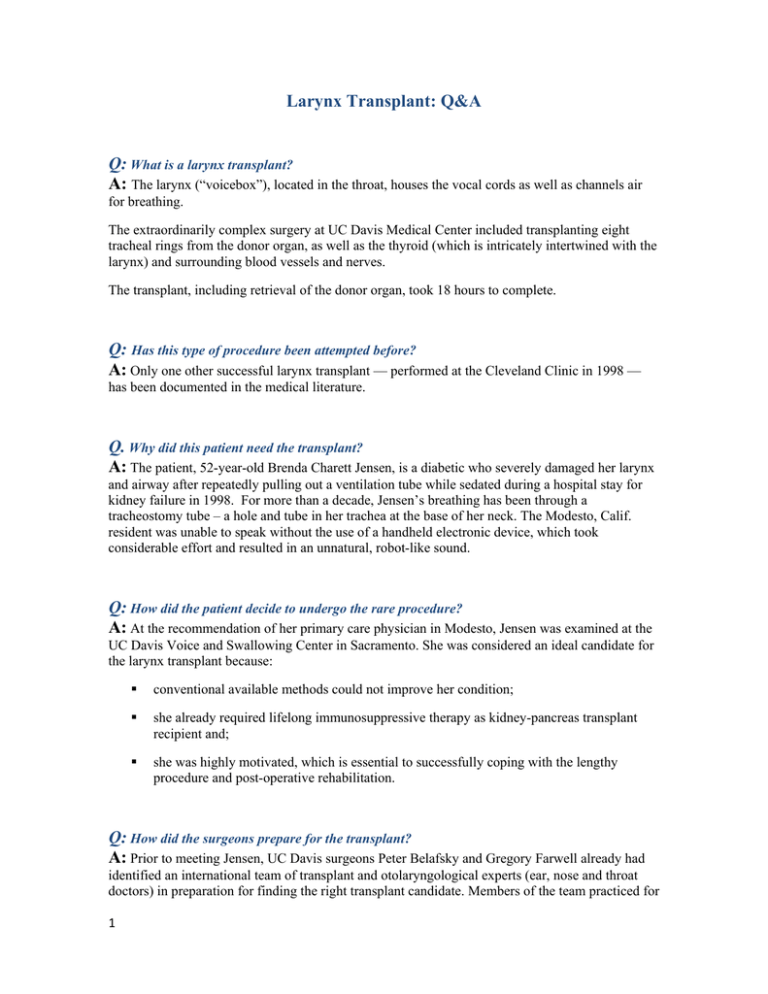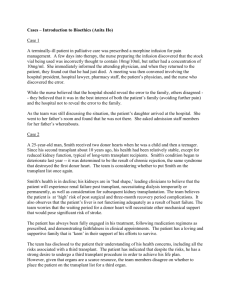Larynx Transplant: Q&A Q: A:
advertisement

Larynx Transplant: Q&A Q: What is a larynx transplant? A: The larynx (“voicebox”), located in the throat, houses the vocal cords as well as channels air for breathing. The extraordinarily complex surgery at UC Davis Medical Center included transplanting eight tracheal rings from the donor organ, as well as the thyroid (which is intricately intertwined with the larynx) and surrounding blood vessels and nerves. The transplant, including retrieval of the donor organ, took 18 hours to complete. Q: Has this type of procedure been attempted before? A: Only one other successful larynx transplant — performed at the Cleveland Clinic in 1998 — has been documented in the medical literature. Q. Why did this patient need the transplant? A: The patient, 52-year-old Brenda Charett Jensen, is a diabetic who severely damaged her larynx and airway after repeatedly pulling out a ventilation tube while sedated during a hospital stay for kidney failure in 1998. For more than a decade, Jensen’s breathing has been through a tracheostomy tube – a hole and tube in her trachea at the base of her neck. The Modesto, Calif. resident was unable to speak without the use of a handheld electronic device, which took considerable effort and resulted in an unnatural, robot-like sound. Q: How did the patient decide to undergo the rare procedure? A: At the recommendation of her primary care physician in Modesto, Jensen was examined at the UC Davis Voice and Swallowing Center in Sacramento. She was considered an ideal candidate for the larynx transplant because: conventional available methods could not improve her condition; she already required lifelong immunosuppressive therapy as kidney-pancreas transplant recipient and; she was highly motivated, which is essential to successfully coping with the lengthy procedure and post-operative rehabilitation. Q: How did the surgeons prepare for the transplant? A: Prior to meeting Jensen, UC Davis surgeons Peter Belafsky and Gregory Farwell already had identified an international team of transplant and otolaryngological experts (ear, nose and throat doctors) in preparation for finding the right transplant candidate. Members of the team practiced for 1 the surgery on animal models and human cadavers and developed a detailed surgical protocol to ensure the transplant would run smoothly. Q: How was the transplant performed? A: The team retrieved the donor’s entire larynx, thyroid and a lengthy segment of the trachea during a six-hour procedure. After removing the organ, the team immediately tested it using a saline solution to ensure that the larynx was healthy and would permit good blood flow (revascularization). The organ was then placed in an icy saline solution until transplantation. Surgeons in an adjacent operating room removed the patient’s damaged larynx and prepare the transplant site for the new organ, which required reconnecting five nerves, three arteries and two veins. Much of the delicate implant work required microsurgical techniques, with surgeons working simultaneously on each side of the patient to suture the organ into place. Q: What if the transplant failed during or after surgery? A: The larynx would have been removed and not replaced. Jensen would not have been worse off than before the transplant, as her larynx already was nonfunctioning. People are able to live a normal lifespan without a larynx. Q: What about the organ donor? A: Golden State Donor Services in Sacramento coordinated the organ donation, checked for blood-type compatibility, and obtained permission from the donor’s family to obtain the organ for surgical research purposes. Although the donor’s gender was not a criterion for the transplant organ, the donor was female. Her family chose to have her remain anonymous. Q: When did the patient first speak and does she have the donor’s voice? A: Thirteen days after the transplant, on Oct. 29, 2010, Jensen voiced her first words in more than 10 years without the use of an electronic device. Her voice was low and coarse but understandable. The sound of the voice is Jensen’s own and not that of the donor. An individual's unique voice a function of the way the sound travels and resonates through the mouth and nose and is formed by the movement of the tongue and lips. Q: Has the patient fully regained her ability to talk, eat and drink? A: Jensen still depends on the tracheostomy tube for breathing and is still receiving nutrition via a feeding tube. Before being allowed to eat and drink again, Jensen must be able to safely swallow, without food and liquid going down her airway. She currently is doing rigorous, daily swallowing exercises to stimulate nerves and muscles and restore throat sensation and function, which is improving daily. Her surgeons anticipate that she will be able to eat and drink in the near future and hopefully have her breathing tube removed at some point. 2 Q: Were there any other concerns with performing this type of transplant? A: In addition to the risks of surgery, a transplant requires lifelong use of immunosuppressant medications — a therapy associated with a higher chance of developing infections and certain cancers — so that the donor organ is not rejected. Because living with a nonfunctioning larynx or living without a larynx is not life-threatening, the larynx transplant is considered an elective procedure. Jensen already was taking immunosuppressant medications for a previous kidney-pancreas transplant. For the other documented case performed in 1998, the patient decided that the potential benefits of recovering his voice outweighed the risks. Q: What are the benefits of this transplant? A: The patient’s surgeons say one of the biggest benefits of this transplant can be seen in Ms. Jensen's smile. They see the joy in her eyes as she has regained the ability to speak in a normal voice. In a larger sense, the lessons learned about reconnecting and restoring nerves and blood vessels, and the transplant rehabilitation are highly relevant for future transplants and laryngotracheal repair. Along with the multidisciplinary teamwork that developed in the course of this undertaking, the operation also offers insights that can help stem cell researchers who are exploring the regeneration of laryngeal tissue. Through each transplant, physicians also gain a tremendous amount of knowledge on the risks of such procedures and how to avoid them, as well as a better understanding about the potential for organ rejection and how to manage it, and how patients rehabilitate after receiving a new larynx. Q: What can the patient expect over the next year? A: Currently, the patient can exhale but has difficulty inhaling, so she must rely on the tracheostomy tube to breathe. She still cannot safely swallow food or liquid, and to speak, she must cover the tracheostomy tube, which will remain in place for an undetermined amount of time. As the larynx continues to heal and Jensen regains nerve and muscle function and sensation in her throat, she hopes to be able to swallow safely and eventually have the tube removed. Q: Who was on the transplant team? A: The transplant team was led Gregory Farwell, associate professor of otolaryngology at UC Davis Health System, and included Peter Belafsky, associate professor of otolaryngology at UC Davis Health System; Martin Birchall, professor of laryngology at the University College London Ear Institute in England; Paolo Macchiarini, professor of regenerative surgery at the Swedish medical university Karolinska Institutet; and Quang Luu, assistant professor of otolaryngology at UC Davis Health System. The entire transplantation involved more than two dozen physicians, nurses, technicians, transplant coordinators and other UC Davis medical personnel. 3



